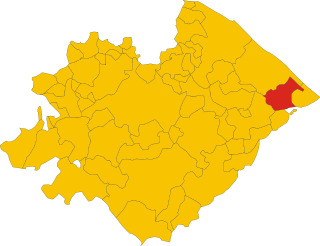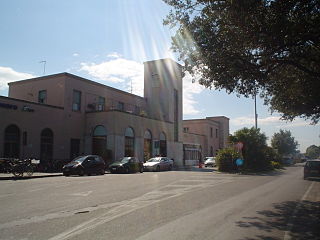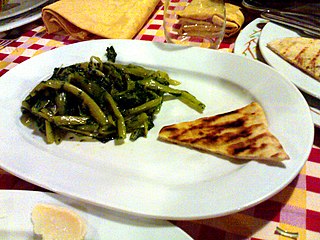
Marche is one of the twenty regions of Italy. In English, the region is referred to as The Marches. The region is located in the central area of the country, bordered by Emilia-Romagna and the republic of San Marino to the north, Tuscany to the west, Umbria to the southwest, Abruzzo and Lazio to the south and the Adriatic Sea to the east. Except for river valleys and the often very narrow coastal strip, the land is hilly.

The University of Urbino "Carlo Bo" is an Italian university located in Urbino, a walled hill-town in the region of Marche, located in the north-eastern part of central Italy.

Fano[ˈfaːno] is a town and comune of the province of Pesaro and Urbino in the Marche region of Italy. It is a beach resort 12 kilometres southeast of Pesaro, located where the Via Flaminia reaches the Adriatic Sea. It is the third city in the region by population after Ancona and Pesaro.

The Province of Pesaro and Urbino is a province in the Marche region of Italy. Its capital is the city of Pesaro. It also borders the state of San Marino. The province is surrounded by San Marino and Emilia Romagna in the north, Umbria and Tuscany in the west, Ancona in the south and the Adriatic Sea on the east. The province has an enclave of the Umbrian commune of Citta' di Castello named Monte Ruperto. The province is also known as "Riviera of Hills". It is mostly covered by hills and is popular for its beaches.
The music of the Marche, a region of Italy, has been shaped by the fact that the entire region is a collection of small centers of population. There is no cultural giant to be found—no Florence or Naples—that might have shaped the cultural and musical expressions of the entire region. There is not a town in the region with more than 100,000 population, but there are 246 total towns, and they support no fewer than 113 theaters, a cultural building boom that started in the late 18th century. Historically, the entire area was home to a great number of monasteries and abbeys in the Middle Ages, institutions that had choirs and were active in the musical lives of the inhabitants. That period is still obscure and is currently the subject of musicological research. In the modern age, the region has a vibrant musical life.

Cantiano is a comune (municipality) in the Province of Pesaro e Urbino in the Italian region Marche, located about 100 km (62 mi) west of Ancona and about 70 km (44 mi) southwest of Pesaro. The Burano flows in the town.

Mondolfo is a comune (municipality) in the Province of Pesaro e Urbino in the Italian region Marche, located about 35 kilometres (22 mi) northwest of Ancona and about 25 kilometres (16 mi) southeast of Pesaro, on the Adriatic Sea.

Piandimeleto is a comune (municipality) in the Province of Pesaro e Urbino in the Italian region Marche, located about 90 kilometres (56 mi) west of Ancona and about 45 kilometres (28 mi) southwest of Pesaro.

San Costanzo is a comune (municipality) in the Province of Pesaro e Urbino in the Italian region Marche, located about 40 kilometres (25 mi) northwest of Ancona and about 20 kilometres (12 mi) southeast of Pesaro.

Sant'Angelo in Vado is a comune (municipality), site of Ancient Tifernum Metaurense and former bishopric in the Province of Pesaro e Urbino in the central Italian Adriatic region Marche.

Tavullia is a comune (municipality) in the Province of Pesaro e Urbino in the Italian region Marche, located about 70 kilometres (43 mi) northwest of Ancona and about 15 kilometres (9 mi) southwest of Pesaro. Until December 13, 1938 it was known as Tomba di Pesaro.

The Cesano is a river in the Marche region of Italy. Its source is near Monte Catria on the border between the province of Perugia and the province of Pesaro e Urbino. The river flows northeast through Pesaro e Urbino before forming the border between Pesaro e Urbino and the province of Ancona for a short distance. It continues flowing northeast through Pesaro e Urbino and flows past Pergola before becoming the border with Ancona again near San Lorenzo in Campo. The river flows northeast near Mondavio, Corinaldo and Monte Porzio before the province of Ancona extends westward beyond the bank of the river for a short distance near Mondolfo. Finally, the river flows into the Adriatic Sea north of Senigallia and south of Marotta and Fano.

Fano Airport is an airport in Italy. located 1 km southeast of Fano and 10 km northwest of Mondolfo in the province of Pesaro and Urbino in the Marche region of Italy.

Sebastiano Ceccarini (1703–1783), born in Fano, was an Italian Baroque painter. He was a student of Francesco Mancini and the teacher of his nephew Carlo Magini.

Ancona railway station, sometimes called Ancona Centrale, is the main railway station of Ancona, Region of Marché. It is the most important station of the region and is owned by the Ferrovie dello Stato (FS), Italy's state-owned railway company.

Faenza railway station serves the city and comune of Faenza, in the region of Emilia-Romagna, northern Italy. Opened in 1893, it forms part of the Bologna–Ancona railway, and is also a terminus of two secondary railways, linking Faenza with Lavezzola and with Ravenna, and with Florence, respectively.

Pesaro railway station serves the city and comune of Pesaro, in the region of Marche, central Italy. Opened in 1861, it forms part of the Bologna–Ancona railway.

The 1930 Senigallia earthquake struck the city of Senigallia in central Italy on October 30. It occurred just a few months after the destructive 1930 Irpinia earthquake, which had caused over 1400 casualties in the southern part of the country.

The Bologna–Ancona railway is an Italian railway that connects the city of Bologna with the city of Ancona, passing through the Po Valley to Rimini and along the Adriatic coast for the rest of the line.

Crescia[ˈkreʃʃa] is a thin Italian flatbread typically prepared in Marche and Umbria. The crescia probably has a common ancestry to the piadina, to be found in the bread used by the Byzantine army, stationed for centuries in Romagna, in the north of the Marche (Pentapolis), and in the Umbrian Valley crossed by the Via Flaminia. The food is also known by the common name of "white pizza".




















